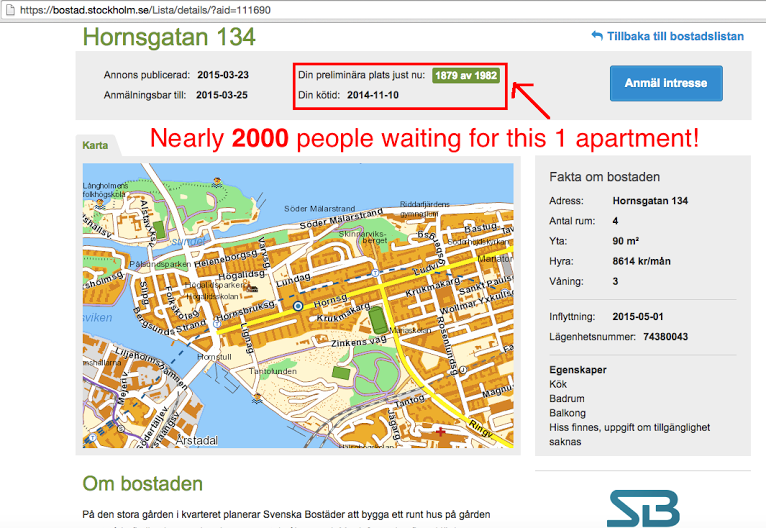A Letter from Stockholm on Rent Control
(The following was written by a resident of Stockholm as a letter from Stockholm to Seattle. You can watch last week’s rent control debate in it’s entirety here)
Dear Seattle,
I am writing to you because I heard that you are looking at rent control.
Seattle, you need to ask your citizens this: How would citizens like it if they walked into a rental agency and the agent told them to register and come back in 10 years?
I’m not joking. The image above is a scan of a booklet sent to a rental applicant by Stockholm City Council’s rental housing service. See those numbers on the map? That’s the waiting time for an apartment in years. Yes, years. Look at the inner city – people are waiting for 10-20 years to get a rental apartment, and around 7-8 years in my suburbs. (Red keys = new apartments, green keys = existing apartments).
Stockholm City Council now has an official housing queue, where 1 day waiting = 1 point. To get an apartment you need both money for the rent and enough points to be the first in line. Recently an apartment in inner Stockholm became available. In just 5 days, 2000 people had applied for the apartment. The person who got the apartment had been waiting in the official housing queue since 1989!
Rent controls reduced my housing supply and promoted a lack of availability in my existing housing stock. This was a surprise because the Swedish Government didn’t cap rents directly- it limited rises to those negotiated between the landlord and tenant associations; based on analysis of costs and apartment ‘utility values’ that described location and apartment quality.
I also noticed landlords started selling off rental apartments to owner-occupiers. Why? The rent control means rental apartments have two sale values simultaneously – a value as a rental apartment, and a higher value as a private condominium. Because rent control lowers a property’s value as a rental apartment, landlords withdrew rental apartments and started selling them at a higher price as private condominiums. This reduced the number of rental apartments available within the existing housing stock. So, if you don’t want to wait you have to save 20% deposit and buy the place you want.
It gets worse. Rent control divided renters into two distinct classes – ‘first-hand’ contract renters and ‘second-hand’ contract renters. The first hand renters generally enjoy unlimited tenure security and low, rental increases. The ‘second-hand’ contract renters have been reduced to hopping between short term sublet rooms or sublet apartments the first hand renters hold when the first hand renters go on summer vacation, move in with their new partner or move to another city for work. In other words, tenure security was extended for some renters only by reducing it for other renters.
It must be remembered that the social function of profit is to signal to society where more resources need to be invested and provide the incentive for people to invest in accordance with those needs. The higher the profit, the greater the need, and the more powerful the incentive is to meet that need.
Government does have a role to help move things along and speed things up. A stick-and-carrot approach of a land tax on the value of all land (i.e. ignoring the value of buildings) to fund subsidies and co-investments for new apartment construction, and rental relief payments, should be seriously looked at before it is too late. Land value taxation promotes construction, isn’t passed on to renters, and generates increasing revenue as land values increase. Subsidies for new rental apartments also promote construction.
Rising rents and housing affordability do require collective political action. But rent controls are not the answer; they will make the problem even worse because they will destroy housing availability and not build a single new house. Land value taxation and new apartment subsidies are answers.
Seattle, rent controls don’t work – just ask my good friend, San Francisco.
With Love,
Stockholm.
Linked material:
What we do – Hyresgastforeningen
http://www.hyresgastforeningen.se/In_English/Sidor/What-we-do.aspx
“Your rent is basically determined by the ‘utility value’ of your apartment. Utility value means that the rent should be proportionate to the quality and standard of the apartment. We think this is reasonable because it results in fair rents for everyone. The rent should reflect the general value that tenants assign to various characteristics of their housing. This includes things like the size of the apartment, number of rooms, floor plan, standard, condition, the housing environment, the location of the building, local services and the attractiveness of the area.”
Rent Setting in Sweden SABO
http://www.sabo.se/om_sabo/english/Documents/Rent%20setting%20in%20Sweden.pdf
Swede endures 28-year wait for Stockholm flat
http://www.thelocal.se/20130328/46996
Stockholm City Council Housing Service waiting statistics (in Swedish –use Google translate to read)
http://bostad.stockholm.se/statistik/
Swedish Housing Crisis Committee Report (2014)
http://www.bokriskommitten.se/wp-content/uploads/2014/09/Bokriskommitten_eng_web.pdf
Land value taxation- Earthshare Canada
http://www.youtube.com/watch?v=jFQgOy-5Tng
Land Taxation – Tax Justice Network
http://www.taxjustice.net/cms/upload/pdf/TJF_6-1-1.pdf
Why land value taxes are so popular, yet so rare
http://www.economist.com/blogs/economist-explains/2014/11/economist-explains-0
“Landlords are unable to pass the tax on to tenants, because the supply and demand of rented land is unchanged”




